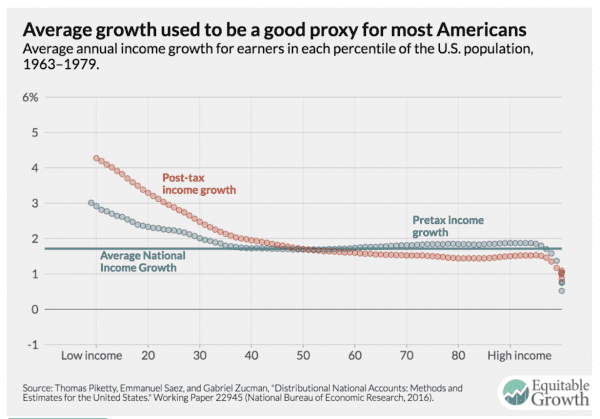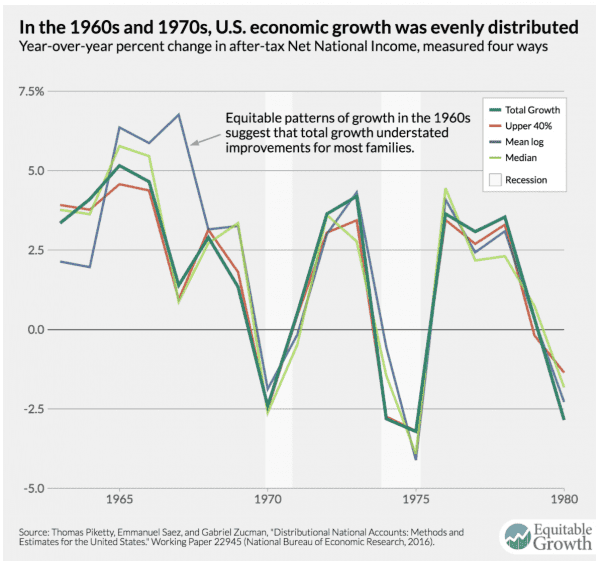
If you look at the numbers, the economic recovery under the Trump and Obama administrations is a story of steady growth — the US economy grew by 2.3 percent in 2017, and President Donald Trump was basically shouting from the rooftops about 4.1 percent growth last quarter. But it’s not being experienced that way by everyone.
Wages are still growing overall slower than they have historically, even though workers in the bottom 40 percent of income distribution are starting to see them pick up. Hourly wages, adjusted for inflation, dropped by 0.2 percent in July.
And many Americans are struggling in ways that seem out of step with a booming economy: A recent Urban Institute survey found that last year 40 percent of American families struggled to meet at least one of their basic needs, including buying food, paying medical bills, or covering utility bills, rent, or mortgage.
But those gaps don’t show up in official measurements like the GDP, which measures growth in the overall economy. Now Democratic Sens. Chuck Schumer and Martin Heinrich are trying to change that. On Tuesday they are introducing a new bill that seeks to shed light on how economic growth in the United States is shaking out for individual Americans.
The idea, they say, is to shed light on where economic prosperity is showing up across different income groups — and, potentially, where it’s not.
The bill, the Measuring Real Income Growth Act of 2018, would require the Bureau of Economic Analysis (BEA), which releases quarterly GDP numbers, to also report how growth is distributed along the income scale. The bureau would have to put together distributional measures of economic growth to be released with quarterly and annual GDP reports starting in 2020, laying out how growth shows up across each decile of earners and the top 1 percent.
The US economy posted strong 4.1 percent growth in the second quarter of 2018, but that’s an aggregate figure based on the amount of goods and services produced in the United States. It doesn’t indicate how that growth might differ for lower- and middle-income Americans, and it doesn’t reflect that, since the 1980s, economic growth has overwhelmingly benefited the wealthy more than the poor.
There are some questions about how the bill would work: The bureau would have to come up with a way to measure and report inequality, for example. And some experts question whether it’s really necessary. But its authors hope it will draw more attention to income inequality in America and perhaps even get policymakers to act.
“We spend a lot of time here in the United States and other countries trying to measure what economic success looks like,” Heather Boushey, chief economist at the Center for Equitable Growth think tank, who has studied the issue extensively, told me. “What really matters is what does [GDP growth] look like for people? For families? Is that growth translating?”
The Measuring Real Income Growth Act will try to combine economic growth and income metrics
Schumer’s and Heinrich’s bill would require the BEA to produce a new metric, the “income growth indicator,” or IGI, to be reported quarterly and annually with GDP numbers starting in 2020.
“America’s working families deserve the full picture when the federal government publishes data showing how the economy is doing, especially with quarterly GDP numbers,” Schumer, the Senate minority leader from New York, said in a statement. “For too long, we have relied on GDP data as a bellwether for how Americans were faring in our economy.”
Producing such statistics would require some legwork. Right now, the best information the government has comes from reports from the Consumer Population Survey and Congressional Budget Office and tax-return data from the IRS. But they’re reported separately from the numbers we think of as indicating economic health.
The census’ income and poverty report, for example, doesn’t capture the richest Americans, and the CBO’s report doesn’t come out regularly. (The best publicly accessible data combining economic growth and income inequality is from researchers.)
Boushey and other researchers at the Center for Equitable Growth have previously tried to game out how the measure might work — and what the results might look like. They used datasets created by economists Thomas Piketty at the Paris School of Economics and Emmanuel Saez and Gabriel Zucman at the University of California Berkeley on the distribution of national income.
What they found is that total economic growth and growth experienced among different income segments of the population largely mirrored one another in the 1960s and 1970s, but in the 1980s, something changed.
From 1963 to 1980, average national growth was close to the growth experienced by most Americans: As the economy grew — about 1.7 percent per year after inflation — their income grew by about the same amount.

Net national income growth was also relatively even across income groups, with an exception in the mid-1960s, which were especially good for those below the median income.

But in the 1980s and beyond, there was a shift. From 1980 to 2014, only the top 10 percent of earners have seen their incomes improve above the average for the rest of the country.

Growth measurements began to diverge: The overall economy grew, but it wasn’t translating into gains for middle-income Americans.
Requiring the BEA to produce distributional measures along with GDP growth that show how economic growth is working for different income levels would paint a better picture of the broader experience of the economy.
“When you use this metric, it gives you a very different understanding of the last 50 years of the US economy,” Boushey said.
In recent decades, the numbers show, economic growth and national income share have increasingly gone to the wealthiest Americans in recent decades. But that’s not the way it’s always been.
“Instead of focusing on one economic indicator closely watched by investors, we should be examining data that captures why many families are still struggling to make ends meet,” said New Mexico’s Heinrich, ranking member of the Senate Joint Economic Committee. He added that only looking at GDP growth to assess the state of the economy “simply does not paint the whole picture.”
Income inequality is a problem in America
The bill, if passed, would force the federal government to pay more attention to inequality. But presenting the legislation also gives Democrats a talking point to counter Trump’s bragging about strong GDP growth. (Trump and the GOP trumpeted the second quarter’s 4.1 percent growth, and revised numbers come out on Wednesday.)
Some experts, though, are skeptical.
Jeffrey Miron, an economist at Harvard University and director of economist studies at the libertarian Cato Institute, said he sees the proposed legislation as an attempt to bring more attention to the issue of income inequality but expressed doubts that such a measure was really necessary or would make sense to calculate.
“If the government starts mandating this kind of reporting, it raises a bunch of hard issues, since the ‘right’ measure of inequality is not so obvious. Do we examine inequality across individuals? Or families?” he said. “Seems to make a difference. Do we adjust for government transfers and taxes? Also seems to make a difference.”
Dean Baker, an economist at the progressive-leaning Center for Economic and Policy Research, also expressed doubts. Current income data from the census and IRS is limited and retrospective, and fielding new surveys to produce the metric the Schumer-Heinrich legislation is proposing would be difficult and, initially, perhaps inaccurate.
“I’m just not sure this is at all helpful,” he said. “It might be better to get an official release on something like the tax data when it becomes available with a year or so lag.”
Boushey, from the Center for Equitable Growth, acknowledged that figuring out the measurement might take some time — but it’s worth trying.
“Yes, it is work for the BEA, but they have all the data,” she said. The proposed legislation authorizes appropriations for the Commerce Department to implement new reporting.
“My guess is that anybody that’s opposed to this is thinking about whether or not they want Americans to know who gained,” Boushey said. “When it’s 4.1 percent growth, they don’t want people to know that that growth most likely went to the top 1 percent.”
Sourse: vox.com






